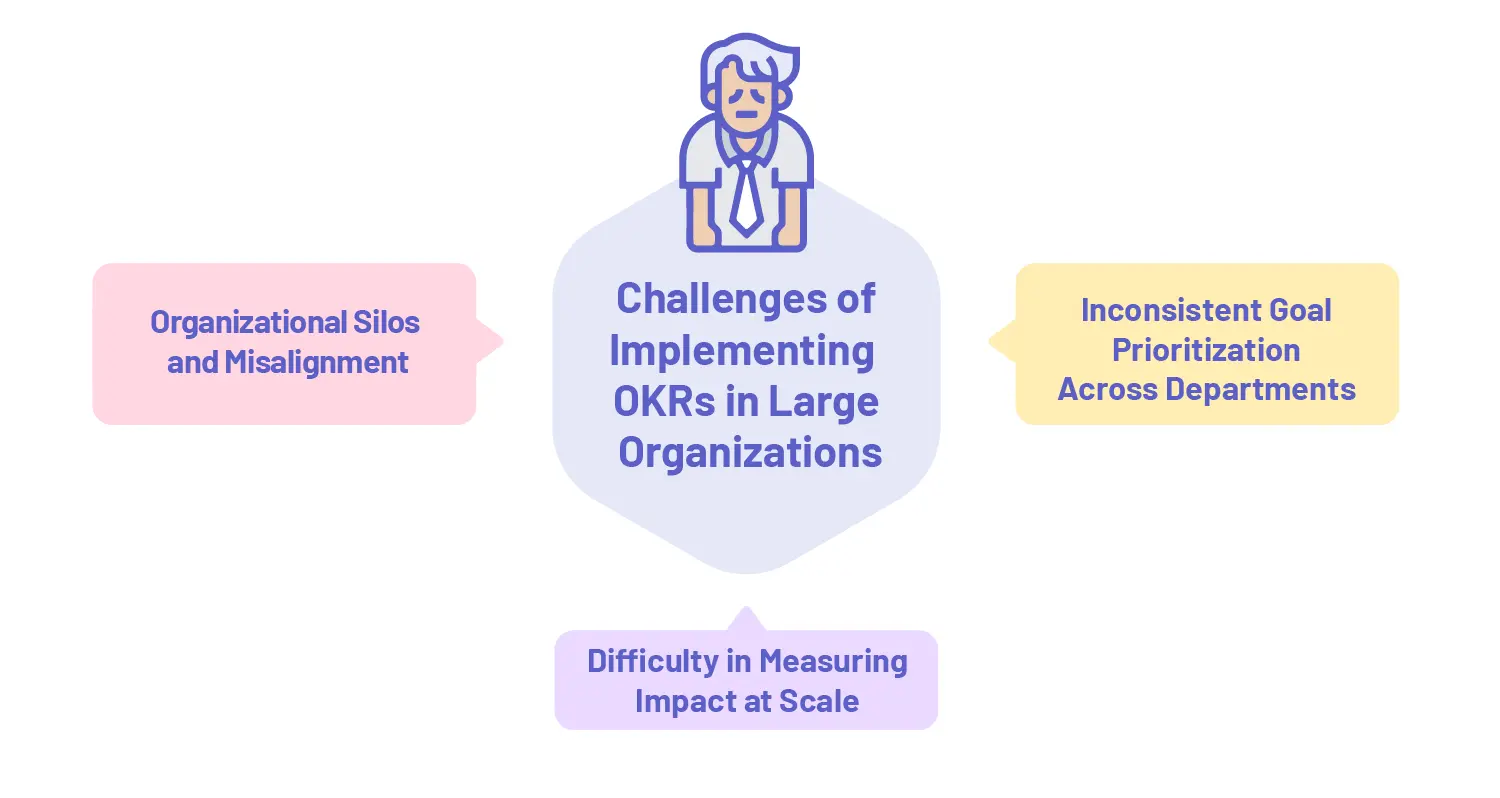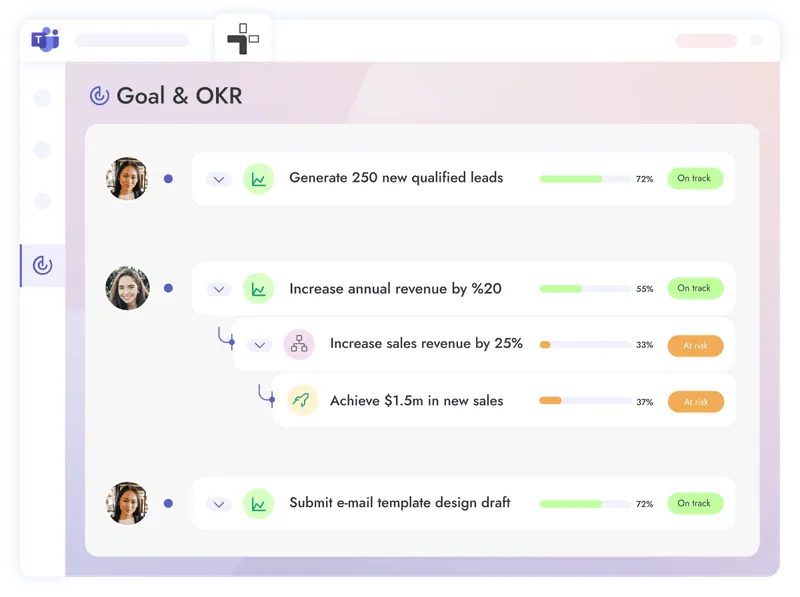Get the Ebook
.svg)
Despite widespread adoption, OKRs often fall short of their potential in large enterprises. According to a study by Harvard Business Review, only 55% of middle managers can name even one of their company's top five priorities, and just 29% of employees say their work is aligned with company goals.
Scaling OKRs across multiple departments and leadership layers is a complex and nuanced process. While conventional methods such as conducting regular goal check-ins and goal-setting templates are helpful, they are not enough. If your team does not have a structured framework around OKR tracking, then goal alignment will more than likely start unraveling within the first couple of months, with individuals working largely unaware of the broader organizational strategy.
This guide explores how to cascade OKRs in large companies effectively, drawing on proven practices for OKR implementation in enterprises. You’ll learn how to:
The larger the organization, the harder it becomes to keep everyone moving in the same direction. Teams are filled with specialized experts in their field, focusing on their own niche, while not having the bandwidth to see the larger organizational objectives without a solid system.
OKRs provide that system.
For large companies, OKRs support strategy execution at scale. This is achieved by helping teams focus on what truly matters. They connect top-level priorities to team goals and individual contributions.
This is also where OKRs are separated from another heavily favored goal-setting methodology: KPI’s.. While KPIs track performance metrics, like revenue or retention, OKRs guide progress. They focus on forward-looking goals and encourage teams to stretch beyond business-as-usual targets. The two frameworks work best when used together, but it’s the OKR model that brings strategy to life across complex organizations.
Effective OKR goal setting enables:

Rolling out OKRs, let alone any new strategic initiative in an enterprise environment is rarely straightforward. While the framework is designed for alignment and has proven to be successful in larger organizations (Case: Google’s OKR Strategy), large organizations often face roadblocks that make consistent OKR implementation difficult in practice.
Below, we’ve highlighted some of the most critical challenges enterprises face when implementing or planning OKRs. These challenges range from communication silos to differentiating priorities. Whatever the challenges may be, with the right talent management strategy they can be overcome.
One of the most common OKR cascading mistakes in enterprises is assuming alignment will happen naturally.
With each department operating within its own silo, broader organizational strategy execution suffers. The enterprise might set an organizational objective of improving customer experience, but if each department is focused on their individual objectives of hitting certain numbers or checkpoints, they might find themselves in isolated projects that have little to no connection to the desired outcome.
Without deliberate cross-functional coordination across departments, OKRs lose their purpose. Teams end up working hard, but not always in the same direction. The result is a high-performance culture, with no results to show for it.
Avoid this by making alignment a step, not an assumption. Every team should be able to articulate how their OKRs contribute to broader company objectives. Cross-functional communication and alignment across departments, should be a core aspect of your company culture.
When departments define their goals in isolation, you might find that sooner or later, inconsistencies start to show.
Some teams may play it safe by setting goals they can easily achieve, perfectly optimized to score higher on performance rating scales.Others may go too far in the opposite direction, choosing ambitious stretch goals that are unachievable or disconnected from real business needs. Neither approach supports effective OKR alignment.
For example: if Sales sets a stretch goal to increase outbound volume by 40%, but Marketing doesn’t plan to support that with additional campaigns, both teams miss their mark. This is a clear case of poor OKR alignment, not poor performance.
To avoid this, leaders need to collaborate during goal-setting and performance management cycles and review OKRs together before finalizing them.
Enterprise-level OKR success depends on ambition being coordinated as opposed to individuals seeking excellence on their own.
In a large organization, it’s easy to lose visibility once OKRs move beyond the executive layer. Teams might complete projects, but it’s unclear whether those efforts are actually moving the needle on strategic goals.
This is where the difference between OKRs vs KPIs becomes important.
Measuring OKR impact requires a more nuanced approach than tracking KPIs. It involves assessing directional progress, qualitative outcomes, and whether teams are focused on the right problems. At scale, this demands clear reporting systems and regular check-ins.
The real key to achieving success in OKRs when you are an enterprise organization is to achieve complete alignment across different organizational levels. Individual OKRs should support larger departmental goals, and those departmental goals should be in service of the broader company objectives. Throughout these process, everyone should be aware of just how their efforts are supporting those overarching company goals.
To cascade OKRs in large companies effectively, you need a structured, transparent approach that bridges strategy and execution. That means involving both leadership and frontline teams in the process.
Many OKR implementation failures happen when executives hand down vague objectives and expect teams to figure out the rest.
Effective OKR alignment in large organizations strikes a balance:
Company Objective: Improve customer retention by 15%
Product Team OKR: Launch two features that directly address top churn reasons identified in NPS feedback
Customer Success OKR: Increase onboarding completion rate from 65% to 85% for new customers
The approach given in this cascading OKR example creates both alignment and ownership. Everyone sees the connection between strategy and their role in delivering results.
Once strategic goals are clear, each department should translate them into context-specific OKRs. This is where knowing how to write OKRs makes a big difference. It is also crucial to know how many OKRs you should be setting. Even vague top-level OKRs can be made actionable when tailored to a team’s capabilities.
Here are two simple OKR examples:
Marketing OKR
Objective: Generate qualified leads to support revenue growth
Key Results:
Sales OKR
Objective: Expand enterprise client base
Key Results:
These examples show how broad company goals can become precise and measurable at the team level, exactly what OKRs for departments are meant to do.
If you would like to see more OKR examples, you can try this OKR Generator. Simply pick the department you would like to generate OKRs for and it will generate relevant objectives and three seperate key results in service of that objective.
Once departmental OKRs are in place, the final layer is aligning individual goals. The alignment of individual goals with company goals gives employees clarity and motivation, especially when tied to stretch goals that are challenging but realistic.
Stretch goals work best when:
For example, a BDR on the Sales team might own this goal:
Individual Goal: Book 45 qualified meetings this quarter
(Stretch goal: 60 meetings)
Even if they hit 52, that’s a win and it reinforces the importance of going beyond minimum expectations.
This layered OKR alignment from company, to team, to individual is what makes OKR goal setting effective in large enterprises. Without it, OKRs become isolated checkboxes and complience exercises instead of drivers of strategic execution.
All these nuances to the OKR alignment process clearly show that going at this alone without the assistance of an OKR software is near impossible. There are plenty of incredible OKR solutions out there but the best OKR solution should hit the following checkpoints.
If you are in the Microsoft Teams or Outlook ecosystem than the software that answers all these questions with a resounding “Yes!” is Teamflect.

Teamflect is not only the highest-rated OKR Software in the Microsoft Teams App Store and the best alternative to Viva Goals, but a complete performance management platform that brings:
And so much more into an easy to use platform right where your team works. It is the platform to help implement cascading OKRs in enterprise organizations and you can learn more about how it works by taking an interactive tour:
Successfully scaling OKRs across a large organization requires more than a well-written framework. It demands consistency, ownership, and the right infrastructure. Without those elements, even the most promising OKR initiative will lose momentum.
The following best practices for cascading model for OKRs can help you embed the methodology deeply into your culture, ensuring that it supports execution, not just documentation.
Any effort to leverage OKRs at scale starts at the top. Without visible support from senior leadership, teams are unlikely to prioritize the process or take it seriously.
Make OKRs a leadership discipline:
These champions act as internal advocates, helping teams stay focused and ensuring OKRs evolve with the organization’s priorities.
OKRs work best when they’re reviewed and revised consistently. Large organizations need a standard cadence for setting, reviewing, and reflecting on goals. Ideally, quarterly.
This cycle ensures teams stay aligned and can course-correct when priorities shift. It also creates space for structured conversations around impact and progress, which are often missing in fast-paced enterprise environments.
Regularly measuring performance review effectiveness can elevate these conversations by providing insight into how well performance discussions support goal attainment.
A clear OKR cycle typically includes:
Unlike KPIs, which are continuous performance indicators, OKRs are cyclical and forward-looking. This distinction is especially important when evaluating strategic execution.
One of the biggest risks in enterprise OKR implementation is creating departmental echo chambers where teams become laser-focused on their own objectives without considering interdependencies.
To combat this, schedule regular cross-functional alignment sessions where representatives from different departments can:
These sessions become particularly valuable when they're structured around specific company objectives rather than general updates. For instance, if improving customer experience is a top-level objective, bring together Product, Support, Sales, and Marketing to discuss how their respective OKRs contribute to that shared goal.
Many enterprises struggle with OKRs because they set aspirational targets without the data infrastructure to measure progress effectively. This leaves teams guessing about their impact or focusing on activities rather than outcomes.
Implementing a data-driven approach to OKRs means:
For example, if a Customer Success team has a key result to "improve first-response time by 30%," they should have systems in place to track current response times, measure improvements, and understand how those improvements correlate with customer satisfaction.
Implementing OKRs at scale is undoubtedly challenging, but when done correctly, it transforms how large organizations execute strategy. The difference between companies that merely adopt OKRs and those that truly leverage them comes down to thoughtful implementation, clear alignment, and consistent execution.
Ready to transform how your enterprise sets and achieves goals? Teamflect offers the comprehensive OKR management solution designed specifically for large organizations using Microsoft Teams. Our platform seamlessly integrates OKRs with employee performance review software, keeping goals visible where your teams already work.
Don't let another quarter pass with disconnected efforts and misaligned priorities. Schedule your free demo today and discover how Teamflect can help your organization cascade OKRs effectively, drive alignment at every level, and turn strategy into measurable results.
An all-in-one performance management tool for Microsoft Teams
